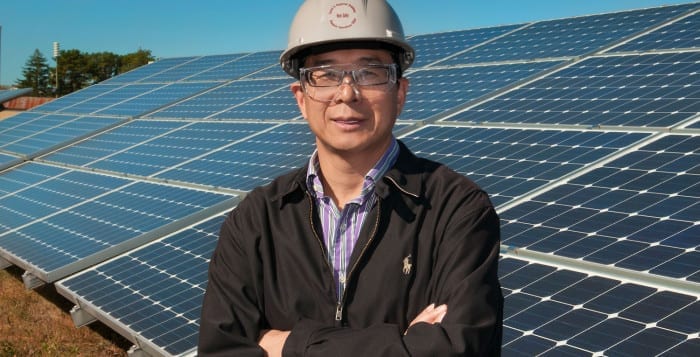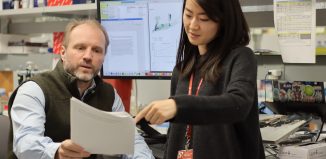BNL’s Yue helps utilities cope with clouds, shifting winds
For film makers, a sudden change in weather conditions can provide a metaphor for a shift in the plot or a change in the relationship among central characters. For Meng Yue, however, the appearance of heavy, thick clouds or a sudden stoppage in wind can disrupt energy flow to a utility.
An electrical engineer in the Department of Sustainable Energy Technology at Brookhaven National Laboratory, Yue explores how the changes in production from renewable energy sources can disrupt the grid, adding either too much energy to the system or not enough.
“The major issue with wind and solar energy is that they are changing all the time,” said Yue. “Because they are intermittent and variable, it creates issues with the grid. We want to keep the grid stable.”
His research, he said, explores how the grid balances between unpredictable supply and demand, both of which can be affected by the same changes. A cold wind, for example, might help generate power while it could also increase the need for heat in homes and offices.
The uncertainties between energy production and consumption might “cancel each other out, but they may also add together,” Yue said. “We have to balance” the supply and use of energy all the time “because we do not want to have any interruption of electricity delivery.”
While he works with the Northeast Solar Energy Research Center at BNL, he spends more of his time using systems analytical models.
In his work, he builds a model for a grid, using solar and wind.
Working with energy is similar to providing any product to consumers, trying to balance between supply and demand.
“If I’m operating my grid, I don’t want to have too much generation or too little,” he said. “Both will cause grid issues.”
As electric grids are designed now, they are capable of sudden fluctuations in demand. When a train from the Long Island Railroad pulls into a station, the system is prepared for this surge although, as Yue describes it, that change is relatively small for the grid, which can withstand some variation.
One of the challenges with renewable energy is that the cost of storing the energy is too high, he said. In the future, as the country continues to increase the amount of energy derived from wind and solar, there may be other storage challenges.
Most of Yue’s work, he said, is computer model based. Running these tests provides some basic information, but it also leads to suggestions and analysis that Yue shares with utilities. He recommends where to put mitigation systems in and how much a utility might need to correct any kinds of problems.
Robert Lofaro, who as the Group Leader in the Renewable Energy Group at BNL is Yue’s supervisor, said Yue has developed and employed a high level of expertise.
“He has a background in electrical power engineering and probabilistic techniques which makes him an excellent smart grid researcher,” Lofaro said. Yue is “very well respected in the smart grid community.”
Yue takes a probabilistic approach to try to capture uncertainties in his studies so that they can be accounted for in decision making. He also reduces uncertainties through a more precise model.
Yue is “quickly becoming known for his work on power system modeling and application of probabilistic techniques to grid operation and planning,” Lofaro said.
Yue has worked closely with meteorologists for years, trying to collect the kinds of forecasts that would inform decision making at utilities. Not only does that help infuse ideas about how to prepare for changes in the amount of energy generated, but it also can aid utilities as they prepare for the likely damage from an approaching storm.
A resident of Miller Place, Yue lives with his wife Qiong Yang, an engineer at a communication company, and their sons Alan, nine, and Clarence, who is five years old. A native of China, Yue has been at BNL for 12 years.
When he travels, he said it’s hard to turn off the part of his brain that is thinking about electric grids and systems.
“No matter where you can go, you can’t avoid seeing the infrastructure like transmission lines,” Yue said. He thinks about how much energy the lines can carry, while he also notices solar or wind farms.







